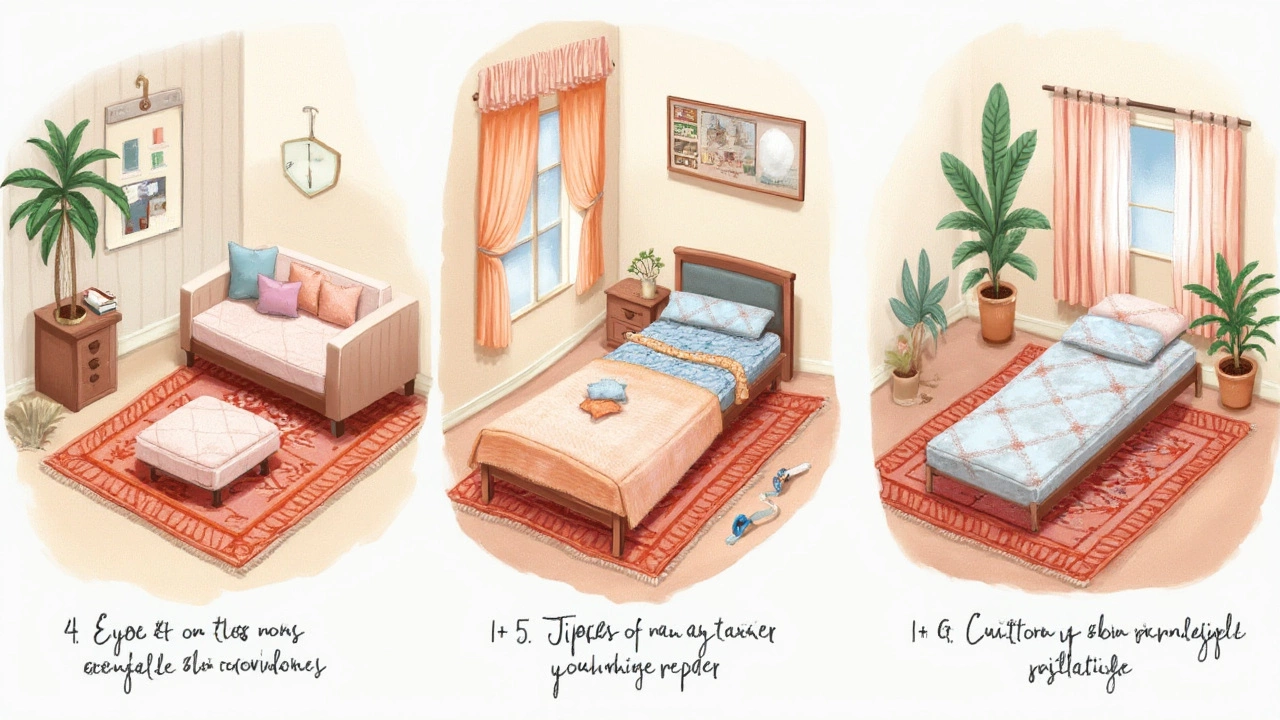Non-removable sofa cushions can often be a source of frustration when they start to show signs of wear or lose their initial comfort. Unlike their removable counterparts, these cushions can't just be unzipped and thrown into the washing machine or partially restuffed. However, armed with a little knowledge and some straightforward tools, you can easily tackle these issues yourself without needing a professional upholsterer.
Whether it's dealing with unsightly stains, sagging foam, or even rips in the fabric, there are practical solutions that promise both functionality and aesthetics. This article dives deep into the world of non-removable sofa cushions, guiding you with techniques and tips that will breathe new life into your seating area and save you the cost of buying a whole new sofa.
- Understanding Non-Removable Sofa Cushions
- Common Problems with Sofa Cushions
- Tools and Materials Needed for Repair
- Step-by-Step Guide to Repairing Cushions
- Tips for Maintaining Sofa Cushions
- Creative Alternatives to Cushion Replacement
Understanding Non-Removable Sofa Cushions
Non-removable sofa cushions are intriguing yet slightly perplexing components of our home furniture. At first glance, they serve as an integrated part of the sofa, designed for both structural support and comfort. Constructed to provide a seamless look, they often blend in such a way that they appear as one with the rest of the sofa. The absence of visible zippers or fasteners contributes to their sleek appearance but can pose a challenge when maintenance becomes necessary. Typically, these cushions are sewn directly into the upholstery, trapping the padding and fabric inside like a secret treasure.
The ingenious design behind these sofa cushions may vary depending on the manufacturer. Some use innovative techniques where the cushion is affixed using overlap or hidden seams. This approach not only adds to the aesthetics but also ensures the cushions stay in place, preventing the usual shifting that can occur with removable designs. While this feature avoids constant adjustment after each use, it's the fixed element that leads to the perplexity when faced with cleaning or repair needs. Often, manufacturers use specific stitching patterns to maintain both firmness and style, which is something to consider when contemplating any DIY repairs.
A common point of interest is the materials inside these cushions. Usually, they are packed with materials like foam, feather, or fiberfill to ensure comfort and longevity. The choice of material directly influences the cushion's resilience and shape retention over time. Foams are typically known for their durability and support, whereas feathers provide unbeatable softness. Fiberfill blends offer a balanced experience with decent comfort and longevity. Understanding these materials can guide you in determining the best approach when the cushion starts to sag or lose its initial plushness.
Interestingly, the rise of non-removable cushions ties back to mid-century design principles where aesthetics often took precedence over practicality. Highlighting this trend, renowned interior designer Amelia Pearson once noted,
“The art of living room design is to craft an inviting environment without compromising elegance; the intrinsic unity of elements like non-removable cushions plays a pivotal role in achieving this.”Such preferences highlight the importance of aesthetic unity in home decor while sacrificing the convenience of adjustable components.
When delving into market trends, a notable takeaway is the increased demand for non-removable cushions driven by modern minimalist homes. Data collected by the Furniture Market Group suggests that these cushions account for over 60% of current living room furniture designs. This inclination towards fixed cushions aligns with consumer desires for low-maintenance, streamlined furniture options that complement contemporary living spaces. It's worth noting that despite their convenience in staying put, these cushions require a certain level of commitment to upkeep and repair that may be unexpected for new owners.
Common Problems with Sofa Cushions
The reality of living with non-removable sofa cushions is that they come with their unique set of challenges, posing issues that might get on anyone’s nerves. One of the most common maladies people encounter is the gradual loss of cushion firmness. Over time, repeated use can compress the filling material, stealing that plush, inviting look and feel that was present when the sofa was new. When you sink into a cushion and feel your body nestle far too deeply, it’s a tell-tale sign that your cushion is crying for help. Another widespread issue is uneven wear, often prompted by repeatedly sitting in the same spot or the constant shifting of weight among visitors and family members. This uneven distribution can lead not only to surface sags but also to the fabric becoming overstressed in certain areas, increasing the risk of tears.
Speaking of fabric, stains rank high on the list of grievances. From the accidental coffee spill during an enthusiastic chat to children’s sticky fingers after a snack, sofa cushions seem almost magnetized to potential stains. The fabric, especially if it’s light-colored, becomes susceptible to visible blemishes that can age the sofa before its time. In a study conducted by a furniture care organization in 2023, it was revealed that a staggering 70% of households pointed out visible stains as their primary concern with their sofas. Add to this the inconvenience of not being able to pop these non-removable cushions into the laundry, and you’re left with a formidable cleaning challenge.
Yet another issue comes in the form of odors. Over months and years, everyday use can lead to the cushions absorbing various smells from food, pets, or even the body. Imagine inviting guests over and realizing that your sofa carries a faint—but noticeable—aroma of last week's dinner. It could be quite embarrassing and uncomfortable for both the host and the guests. An interesting piece of advice from upholstery experts suggests regular airing or sunlight, which can help in diminishing low-level odors.
Anna Levine, a renowned upholstery expert, once said, “A sofa isn’t just furniture; it’s an integral part of our living experience. Treat it well, and it repays you with comfort and beauty.”
Even more worrying can be issues related to pests. Dust mites, small insects, and, in rare situations, mold could infest the cushions, especially if they are kept in a humid environment. Regular cleaning and maintaining optimal room humidity can help alleviate such threats. While these problems might seem daunting, addressing them efficiently often comes down to knowing what to look for and taking timely action. Hence, it's crucial to regularly inspect, clean, and maintain your sofa cushions for longevity and comfort.
Tools and Materials Needed for Repair
When you set out to tackle the task of repairing your non-removable sofa cushions, it's critical to equip yourself with the right tools and materials to ensure a successful outcome. While the task might seem daunting at first, having a clear understanding of what you'll need can simplify the process. First and foremost, you'll want a basic sewing kit that includes needles and a strong thread, often the unsung heroes in many cushion repair scenarios. These will allow you to mend any rips or tears in the fabric that may have formed over time. Remember, a strong nylon or polyester thread is preferable because of its durability and strength, which can withstand the pressure of being sat on repeatedly.
DIY upholstery often calls for fabric glue, a non-sew option that works wonders for minor repairs. This is crucial if sewing is not your forte or if the tear is in a tricky spot that needles can't reach. It's also helpful to have a set of fabric patches that match the color and material of your sofa. These can be easily applied with the fabric glue to cover any unsightly areas, restoring the look of your cushion to near-new condition. Another essential tool is a staple gun, especially when reattaching any fabric that might have loosened over time. Accompanied by the appropriate staples, this tool can save you a significant amount of time and effort.
For the filling, foam can be purchased in pre-cut sheets or blocks; memory foam is a popular choice due to its sturdiness and comfort. However, if you're looking for a softer, more traditional feel, consider using polyester batting or cotton filling. Not to be overlooked, a measuring tape ensures that your new foam or batting fits perfectly inside the cushion cover, avoiding awkward lumps or poor fitting. Also, a sharp pair of scissors makes trimming excess fabric or foam a breeze, ensuring clean cuts that don’t fray or lead to further repairs. In some cases, you might discover that a zipper foot or a similar accessory for your sewing machine is necessary to navigate tight spaces within the cushion.
"The right tools transform a challenging task into an achievable project." – Upholstery Magazine
Additional Materials Worth Considering
Consider the often-overlooked but highly beneficial inclusion of Velcro strips in your toolkit. These can help secure loose fabric without permanent alteration, contributing to the cushion's longevity. If your sofa design permits, Velcro can offer a clever solution for removable access, providing further avenues to fix any internal issues. Conversely, a curved upholstery needle can be a valuable addition when working on hard-to-reach areas. This specialized tool allows for precision and avoids unnecessary damage to the surrounding material.
Finally, consider using an iron-on or sew-on adhesive for those who wish to strengthen seams or hem excess fabric edges, proving invaluable when reinforcing high-contact areas. In certain cases, professional-grade steam cleaners may be employed to eliminate stains before repairs, though exercise caution to avoid further damage. Ultimately, the decision to include these specialized items comes down to the specific needs of your repair project and your comfort with their application. With these tools and materials at your disposal, you'll be well-prepared to embark on your repair journey with increased confidence and success.

Step-by-Step Guide to Repairing Cushions
Tackling non-removable sofa cushions can seem daunting, but with a clear guide, you'll find it's more manageable than you might think. The first step in revamping your sofa cushions involves assessing the damage. This is crucial because different problems necessitate distinct solutions, whether the issue lies in the cushion's fabric, the underlying foam, or even both. For most cushion types, the fabric generally doesn't have a seam you can easily access. Here, you need to be ready with a seam ripper, a small but mighty tool that helps you carefully open the fabric along a seam without causing additional damage.
Once you've made a note of the problem, you can start with the repair. If the foam has lost its spring, you'll be happy to know foam replacement can refresh not only its height but its comfort as well. When purchasing replacement foam, density matters. Opting for a high-density option usually results in longer-lasting support, striking that ideal balance between plushness and structure. In an insightful article published in Home Décor Monthly, well-known interior designer Carl Jensen noted,
“Choosing the right density can make a world of difference to the feel of your sofa. It's one factor you should never compromise on.”His advice holds true; better density means your sofa maintains its shape longer, sparing you from constant upkeep.
If the underlying foam is intact but the fabric has seen better days, a patch job might be just what you need. Begin by selecting a fabric that matches your sofa's color or go creative with a contrasting hue for some added flair. Iron-on patches are often the go-to choice here, as they blend ease of application with sturdy adhesion. Set your iron to the appropriate setting, carefully press the patch in place, and allow it to cool. Few repairs blend convenience and craftsmanship as effectively as this. Remember, the key is not to rush. Allow each layer to securely adhere before moving on to the next step, ensuring a more professional appearance.
Let's not overlook the importance of re-sealing your cushion afterwards. Once any foam or fabric repair is complete, ensuring the seam is stitched up securely will protect the work you've done. A curved upholstery needle and heavy-duty thread are your allies here, as they navigate tight spots with greater ease than their regular sewing counterparts. An invisible stitch or ladder stitch often delivers the cleanest finish, rendering your repairs all but invisible. At this point, turning the cushions over for a quick weight test can reveal whether everything has been sealed as it should. If done correctly, your cushion should feel as sturdy and comfortable as ever.
Special Considerations for Unique Fabrics
Before you dive headfirst into your sewing, pause to consider your fabric type. Fabrics like velvet or leather may require more delicate handling to avoid lasting damage during the repair process. Special adhesives are available for these more delicate materials, often providing a better bond without the need for invasive stitching. Specialty shops usually stock multiple varieties tailored for this purpose, so don’t skip the research if your sofa is made of unique or complex materials. Opting for trusted brands can eliminate potential mishaps and maximize the material’s lifespan.
When it comes to DIY upholstery, patience is indeed a virtue. Rushed repairs rarely go smoothly, and you'll find that allocating sufficient time ensures a more polished outcome that satisfies both eye and comfort. Remember, while some abrasions and tears are inevitable over time, following consistent practices makes recurring issues less likely. The satisfaction gained from restoring your sofa to its former glory is irreplaceable, making all efforts undeniably worthwhile.
Tips for Maintaining Sofa Cushions
Keeping your sofa cushions looking fresh and plump requires a diligent approach, especially when dealing with non-removable options. Like any other piece of furniture, these cushions need regular care to prolong their lifespan and preserve their appearance. One of the simplest yet most effective methods is regular vacuuming. By doing so, you can prevent dirt and debris from settling into the fabric fibers, which could otherwise lead to discoloration or wear over time. Invest in a vacuum cleaner with an upholstery attachment, which is specially designed to handle delicate fabrics without causing any damage.
Another key to maintaining your sofa cushions is to regularly rotate and flip them (where possible). This helps to maintain an even wear pattern, ensuring that one side doesn’t bear the brunt of the daily sit-and-stand routine. Even pressure across the cushions helps in preventing the formation of dips and sags, which can create an uncomfortable seating experience. Speaking of pressure, try to avoid using the same seat every time. Encourage family members to mix it up now and then, allowing the cushions a chance to recover and distribute weight more evenly.
Stains, spills, and spots are inevitable, but don’t let them become a permanent part of your cushions. As soon as an accident occurs, it’s crucial to tackle it immediately. Blot instead of scrub to prevent spreading and setting the stain deeper into the fabric. A mixture of mild detergent and water, or even a fabric-safe stain remover, can be applied to a washcloth to gently dab the affected area. Regular fabric protection treatments, such as scotch-guarding, can offer an additional layer of defense against stains. These treatments create a barrier that repels liquids, giving you more time to act before the stain permeates the material.
Considering the use of a slipcover is another viable option. A well-selected slipcover can provide a stylish change while offering protection to the underlying fabric. Slipcovers are easy to clean, and many are machine washable, making maintenance relatively painless. By opting for a slipcover, you can refresh your living space's look as you wish, and take comfort in knowing that your sofa is shielded from potential damage.
"The resilience of your sofa cushions greatly depends on the level of care and maintenance you afford them," says renowned furniture expert Jane Smith of the Home Comfort Institute. "Simple habits, like airing out cushions and promptly attending to spills, can vastly extend the life and look of your beloved furniture pieces."
Lastly, consider the environmental factors as well. Direct sunlight can cause fabrics to fade, and moisture can lead to mold or mildew, especially in humid climates. Placing your sofa away from windows or using curtains to block harsh sunlight can mitigate these risks. If dampness is a concern, ensure good ventilation in your space or use a dehumidifier to control moisture levels. A little consideration of these factors goes a long way in keeping your sofa cushions pristine and your living room aesthetically pleasing.
Creative Alternatives to Cushion Replacement
When your beloved sofa starts showing signs of age with sagging or worn-out cushions, the thought of replacing them completely may seem inevitable. But before you consider this costly option, there are several creative alternatives that can extend the life of your non-removable sofa cushions. These solutions not only save money but also contribute to a more sustainable lifestyle by reducing waste and consumption. First and foremost, you can experiment with adding foam sheets or inserts. This is a relatively straightforward process where you carefully create a small slit in an inconspicuous area of the cushion, allowing access to the inner stuffing. By inserting fresh foam, you can restore the original firmness and shape, instantly improving comfort and appearance.
A second approach might involve using high-quality batting around the existing cushion core. This adds an extra layer that will plump up saggy cushions. Simply wrap the batting evenly, ensuring coverage of all sides before stitching the slit closed with strong thread. Not only does this enhance the cushion’s volume, but it can also provide additional resilience. Additionally, consider exploring specialized cushion pads that have become available in recent years. Designed with versatility in mind, these pads can be strategically placed beneath or around your cushions, offering structural support and better posture without necessitating any drastic changes.
The concept of reversible slipcovers is another creative path to breathe new life into your sofa’s appearance. Slipcovers offer immense flexibility, allowing you to choose from a spectrum of textures, patterns, and colors. They effectively hide wear and tear while being easy to remove and wash, making it possible to vary your living room decor reflecting the seasons or your mood. As David Brooks, a renowned home designer, once said in an interview,
"Reversible slipcovers are the unsung heroes of quick home makeovers, turning bland into bold with just a twist."
If sewing or crafting isn’t your forte, don't shy away from enlisting the help of local craftsmen skilled in upholstery repair. These experts can carefully open the cushion seams and replace or augment the stuffing material while preserving the original finishing. Working with a professional can add years to your sofa's lifespan, plus they often possess a few tricks for finishing edges seamlessly, leaving no trace of intervention. Another out-of-the-box idea is to use stuffing from old pillows or beds, repurposing these materials to fill cushions. Not only is this an eco-friendly solution, but it also provides a comfy fill that gives old cushions a new lease of life.
To further back your efforts, think about rearranging or rotating your cushions periodically. This simple practice will promote even wear across all cushions, focusing usage on less-used areas. It's an effortless yet often overlooked way to manage and extend cushion integrity. For those keen on experimenting, DIY sleeve pockets made of complementary fabric scrap can add personalized flair to any sofa, seamlessly hiding wear while showcasing your creativity. Regardless of the chosen technique, these inventive solutions ensure that replacing non-removable cushions becomes a thing of the past, thus allowing your favorite couch to continue as the focal point of comfort and style in your home. By exploring these practical alternatives, you're making a conscious choice towards adaptable, responsible home management.





